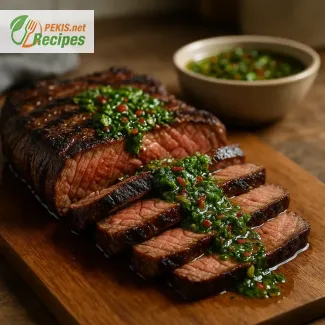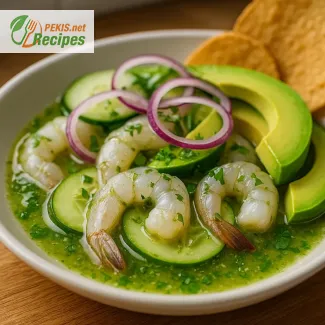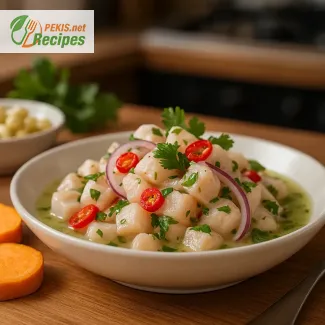Fermented potato pulp Tocosh transforms simple Andean potatoes into a natural probiotic remedy through a slow 30-day water fermentation process. Ready in about 25 minutes of prep with no cooking time, it serves 4 portions of smooth, earthy, and tangy pulp rich in beneficial lactic cultures. Traditionally used to support digestion and immunity, Tocosh can be served warm with honey or savory with cheese. It stays fresh for up to 14 days refrigerated or can be dried into flakes for longer storage, preserving its unique healing and nutritional properties.
Working with traditional Andean fermentation techniques has always been fascinating, especially when ancient methods reveal such depth of flavor and purpose. Preparing Tocosh, a fermented potato pulp, feels like connecting directly to centuries of wisdom preserved in the Peruvian highlands. The transformation from simple potatoes to a living probiotic food is both humbling and rewarding — a reminder of how time and nature collaborate to create balance in every bite.
PEKIS – professional chef and recipe developer with over 25 years of experience in cooking and baking, specialized in European and international cuisine.

Ancient fermentation secrets: unlocking the benefits of Tocosh
The transformation of potatoes into a living Andean probiotic
Hidden high in the Peruvian Andes, where rugged landscapes meet the rhythm of ancient traditions, Tocosh stands as one of the most fascinating fermented foods in the world. Created through a natural process that relies only on potatoes, water, and time, Tocosh is celebrated for its ability to restore gut balance, strengthen immunity, and preserve nutrients through fermentation. Its story blends science and folklore, giving life to a dish that bridges ancestral wisdom and modern wellness.
For generations, Andean villagers have submerged sacks of white or yellow potatoes in pure mountain spring water, allowing them to ferment for several weeks beneath the surface. The natural bacteria and cold water slowly transform the starches into lactic acid, producing a soft, pungent pulp with remarkable probiotic properties. This process doesn’t just preserve the potatoes — it redefines them. Tocosh becomes a functional food, rich in beneficial enzymes and living cultures that nurture the body from within.
A cultural treasure rooted in Andean tradition
The origins of Tocosh reach deep into pre-Incan civilization, where food was more than sustenance — it was medicine. Locals referred to it as a “gift from the Apus,” the mountain spirits believed to guard health and fertility. In traditional Andean medicine, Tocosh was given to those recovering from illness or childbirth, as it was thought to rebuild strength and purify the body. Even today, it remains a trusted remedy in rural Peru, particularly for stomach ailments, respiratory infections, and fatigue.
This deep connection between spirituality, healing, and fermentation has made Tocosh a symbol of Andean endurance. It embodies the same patience and respect for nature that define other ancient fermented foods like miso, kefir, and sauerkraut — each proving that preservation can also be transformation.
The science behind the fermentation process
At its core, Tocosh is a masterpiece of lactic acid fermentation, a natural biochemical process where beneficial microorganisms convert carbohydrates into organic acids. These acids not only preserve food but also improve digestibility and nutrient absorption. During the 20–30 day fermentation, enzymes develop that help break down starches, creating a creamy texture and a slightly tangy flavor.
The end result is more than a dish — it’s a living ecosystem of Lactobacillus species, known to promote gut health and support immune function. In every spoonful, centuries of empirical Andean knowledge meet modern nutritional science.
Why you’ll love this recipe
- Natural probiotic boost that supports digestion and balance.
- Authentic Peruvian heritage preserved through traditional techniques.
- Minimal ingredients, proving simplicity can achieve complexity.
- Distinct fermented aroma that reflects natural transformation.
- Cultural authenticity, offering a glimpse into ancient wellness traditions.
Storing and making ahead
Tocosh keeps remarkably well due to its fermentation. Once prepared, it can be stored in the refrigerator for up to 14 days in an airtight container. For longer preservation, it can be dried into flakes or frozen in small portions, which retain most of its probiotic activity. Avoid reheating it to high temperatures — warmth preserves its life, boiling destroys it.
Related Andean fermentation practices
Fermentation has always been at the heart of Andean food culture. Alongside Tocosh, traditional dishes like Chicha de jora (fermented corn beer) and Mazamorra de camote (sweet potato pudding) represent how Andean people mastered natural preservation. Each dish reflects the same harmony between time, environment, and nourishment that defines Tocosh.
For readers interested in exploring more about fermented foods and digestive wellness, there’s also a detailed guide available on Best Time to Drink Kefir, offering insights into how probiotic drinks can complement traditional preparations like Tocosh.
Creative variations
Modern interpretations of Tocosh give it a new life in contemporary kitchens. Some prefer to blend it with yogurt or milk for a creamy probiotic breakfast, while others sweeten it with honey or molasses to balance the pungent aroma. In savory dishes, it pairs beautifully with cheese, soups, and stews, adding subtle depth and earthy complexity. Chefs experimenting with fusion cuisine have even incorporated Tocosh into smoothies, sauces, and fermented spreads, proving that its versatility stretches far beyond its traditional roots.
The essence of Andean fermentation
Understanding Tocosh means appreciating the beauty of slow transformation. What begins as a humble potato becomes a living food through the patience of nature. Every stage of fermentation represents balance — between water and air, earth and bacteria, flavor and preservation. Its resilience mirrors that of the Andean people themselves: resourceful, patient, and deeply connected to the rhythms of the land.
Fermented potato pulp Tocosh is more than an ancient remedy — it’s a lesson in endurance, simplicity, and respect for natural processes. Within its strong aroma and rustic taste lies a story of survival, nourishment, and timeless culinary wisdom that continues to inspire kitchens and wellness enthusiasts around the world.
- Wash and peel the potatoes thoroughly, removing all dirt and damaged spots.
- Place the clean potatoes into a woven straw bag or wrap them in cheesecloth to allow airflow and water exchange.
- Submerge the bag in a natural spring or large clay container filled with fresh, running water. Use stones as weights to keep the potatoes underwater.
- Let the potatoes ferment for 20–30 days, depending on the water temperature. The colder the water, the longer the fermentation process.
- Once the fermentation is complete, remove the bag and rinse the potatoes well. They should have a soft texture and a distinct fermented aroma.
- Mash the potatoes into a smooth pulp using a wooden spoon or blender.
- Serve the fermented potato pulp warm or at room temperature, optionally sweetened with honey and sprinkled with a pinch of ground cinnamon.
- For a savory variation, it can also be mixed with milk or cheese to enhance the creamy consistency.
Storage:
Store Tocosh in an airtight container in the refrigerator for up to 14 days. For longer preservation, dry it into flakes or freeze in small portions.
FAQ questionWhat is Tocosh and why is it fermented?
Tocosh is a traditional Peruvian fermented potato pulp made by submerging potatoes in running spring water for several weeks. The fermentation process encourages the growth of beneficial lactic acid bacteria, which break down the starches in the potatoes and create a product with probiotic and antimicrobial properties. This method was used in the Andes both for preservation and for natural healing, especially for digestion and immune support.
FAQ questionHow long does it take to make fermented potato pulp Tocosh?
The active kitchen work is short (about 25 minutes of prep), but the fermentation itself takes 20–30 days depending on water temperature and conditions. The long soaking period is essential because it allows the potatoes to ferment slowly in cold, clean water, developing the distinct aroma, soft texture, and probiotic profile that makes Tocosh unique.
FAQ questionWhat does Tocosh taste like?
Tocosh has a strong, earthy, and slightly sour aroma — much more pronounced than common fermented foods. The flavor is often described as tangy, rustic, and fermented, similar in intensity to aged dairy or strong fermented vegetables. Because of that, many people serve it with honey, milk, or cinnamon to soften the taste, or mix it into porridges and soups to balance the fermented notes.
FAQ questionIs Tocosh good for digestion?
Yes. Tocosh is traditionally consumed as a natural gut-supporting food. The long fermentation encourages lactic acid bacteria that may help support a healthy intestinal environment. In Andean folk medicine it was given to people recovering from stomach issues, colds, or weakness. While individual results vary, regularly consuming naturally fermented foods like Tocosh can be a useful part of a digestion-friendly diet.
FAQ questionHow do you store Tocosh once it’s ready?
After fermentation and mashing, Tocosh should be kept in an airtight container in the refrigerator and used within up to 14 days. To extend its shelf life, it can be dried into flakes or frozen in small portions, which helps preserve its functional and probiotic qualities. When reheating or adding to warm dishes, avoid boiling it for a long time so the beneficial cultures aren’t completely destroyed.
FAQ questionCan Tocosh be made milder for people trying it the first time?
Yes. Because Tocosh has an intense fermented smell, it’s common to serve it with sweet or creamy elements. Mixing the pulp with milk, yogurt, cheese, or honey makes the flavor more approachable. You can also add a pinch of cinnamon or combine it into a warm porridge so the final dish keeps the health benefits while becoming more palatable for beginners.
FAQ questionIs Tocosh the same as other fermented foods like sauerkraut or kefir?
Not exactly. Tocosh shares the same principle of lactic acid fermentation, but it uses potatoes and spring water instead of cabbage or dairy. It comes from a distinct Peruvian highland tradition and was developed primarily as a healing and strengthening food, not just as a side dish. Still, it fits perfectly into a modern diet that values fermented, probiotic-rich, and culturally authentic foods.
The story of Tocosh goes beyond its bold aroma and ancient roots — it represents the timeless connection between nature, patience, and nourishment. Through fermentation, ordinary potatoes transform into a living food filled with beneficial microorganisms that support both body and spirit. Each spoonful reflects the balance of science and tradition, offering a glimpse into the Andean understanding of health long before the modern concept of probiotics existed.
Today, fermented foods are celebrated worldwide for their ability to enhance digestion, boost immunity, and restore balance to the gut. Tocosh holds a unique place among them, blending simplicity and authenticity. Its minimal ingredients — just potatoes, water, and time — make it one of the purest forms of natural preservation still practiced.
The earthy and tangy character of Tocosh can surprise first-timers, yet behind its strong flavor lies centuries of wisdom about how to protect and heal the body naturally. Whether enjoyed on its own or mixed into porridges, soups, or smoothies, it continues to serve as a symbol of resilience born from harsh mountain conditions and deep cultural knowledge.
Preserving this Andean legacy means celebrating a sustainable and mindful way of eating — one that honors the environment while nurturing health from within. Tocosh reminds us that even the humblest ingredients, treated with respect and time, can become a powerful source of vitality for generations to come.
Allergens present in the recipe:
- None naturally present
- Possible traces of gluten if served with bread or grains
Tips to eliminate allergens and gluten:
- Use gluten-free honey and avoid cross-contamination from serving utensils.
- When adding toppings or sides, ensure gluten-free grains or dairy-free alternatives for sensitive diets.
- Vitamin C (mg): 18 – supports immune defense and collagen production
- Vitamin B6 (mg): 0.4 – aids metabolism and nerve function
- Potassium (mg): 620 – contributes to normal muscle and heart function
- Magnesium (mg): 28 – important for muscle relaxation and energy production
- Iron (mg): 0.8 – supports oxygen transport in blood
- Phenolic compounds (mg): 25 – help neutralize free radicals
- Flavonoids (mg): 18 – contribute to anti-inflammatory processes
- Carotenoids (mg): 0.3 – support vision and immune response





